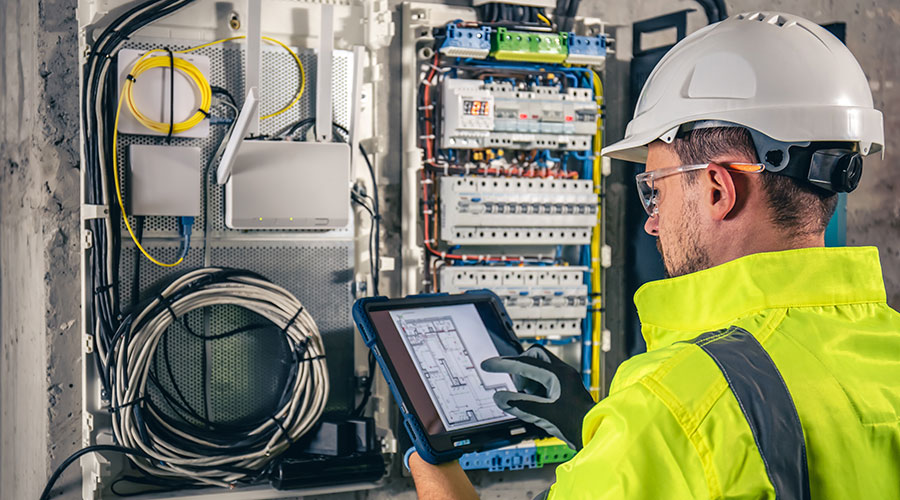How IoT and Smart Technology are Shaping the Future of Electrical Code
Updates to the National Electrical Code are incorporating more tech-first features for facilities.
By Corey Hannahs, Contributing Writer
Emerging technologies are becoming an increasingly important part of building designs and renovations and are continuing to be incorporated as they are developed. The Internet of Things (IoT), for example, is an area of technology that has gained immense traction in the past decade, including devices such as smart thermostats, smoke sensors, LED lighting, smart sprinkler systems, and more. IoT provides the ability to connect equipment, tools, and other assets to a network that can monitor and manage their usage, functionality, maintenance, and performance. Data gathered by these devices and systems can then be leveraged to identify areas of risk and determine opportunities for improved efficiency.
Smart technologies are being adopted at a rapid rate. However, some hesitancy still exists across the sector. Obstacles to adoption include a general apprehension to technology, the initial costs associated with incorporating new tools (although there is often a short payback period), and a loyalty to traditional, tried-and-true ways of doing things. But while the traditional methods might still work, they also work for competitors that may be more willing to evolve old ways of doing things to become more efficient, safe, reliable, and cost effective. As such, even those that may have some initial resistance to technology are beginning to realize that this is the way of the future, and it’s important to get on board sooner rather than later.
As this area of building design and renovation continues to evolve, so must the electrical codes and standards meant to drive safety in the installation and application of these new technologies. With the recent publication of the 2023 National Electrical Code (NEC), we are seeing additions that reflect the tech-first nature of today’s facilities, a few of which are outlined below.
How Smart Tech is Shaping the NEC
Codes and standards like the NEC are continuing to incorporate new technologies into their requirements. While there are not yet NEC changes specific to IoT devices, the installation of those devices from an electrical perspective certainly falls under the scope of the NEC and its general installation requirements. As part of this evolution, other technologies will necessitate specific code requirements and, in some cases, even full articles containing many code requirements on the topic. Regardless of the specifics, all additions and changes relating to new technology are sure to work towards two main end goals: safety and efficiency.
An Eye on Safety and Data Protection
Alongside the rise of IoT devices comes serious considerations about safety and data security. Many buildings that incorporate smart life safety equipment also tie it into networks that are, by nature, susceptible to malicious attacks. Cybersecurity is often utilized as a means of protection in these cases. As such, Section 110.3(A)(8) was added to the 2023 NEC to begin addressing safety within electrical installations from a cybersecurity perspective. This is the first time the term “cybersecurity” has appeared in an NEC edition and is indicative of smart technology’s increasing prevalence in the electrical realm.
Article 110 provides general requirements for electrical installations in the NEC, which incorporates both the examination of equipment and approval of installations. The authority having jurisdiction (AHJ) often uses this section as a reference point to determine what installations and equipment the NEC permits them to oversee and inspect. Adding section 110.3(A)(8) to the 2023 NEC allows the AHJ to examine cybersecurity considerations related to network-connected life safety equipment, addressing its ability to withstand unauthorized updates and malicious attacks while continuing to perform its intended safety functionality.
Additional areas of the 2023 NEC relating to cybersecurity include Section 240.6(D), on cybersecurity for circuit breakers capable of being adjusted remotely, and Section 708.7, on cybersecurity for critical operations power systems (COPS).
While these initial cybersecurity additions to the NEC don’t provide much in the way of requirements, other than the ability for related equipment to be evaluated, they open the door for further cybersecurity expansion in future editions of the NEC.
Strides Towards Electrical Efficiency
To encourage enhanced efficiency, the 2023 NEC also includes a new section, 625.42(A), addressing the use of energy management systems (EMS) with electric vehicle supply equipment (EVSE), which includes what is more commonly referred to as electric vehicle (EV) chargers.
In many cases, especially in residential applications, electrical services do not have the capacity to incorporate the full load of an EV charger being installed onto the existing premises wiring system. Typically, that would mean that the owner needs to upgrade their electrical service in order to incorporate an EV charger, which can be costly. With the NEC now permitting EMS to be utilized with EVSE, provided certain requirements are followed, this means that an owner may be able to incorporate an EV charger into their premises wiring system without incurring the hefty expense of upgrading their entire electrical service. From an industry challenge perspective, the use of EMS with EVSE equipment may also allow multiple EV chargers to share a limited amount of the power from a single circuit and manage the distribution of power through the EMS based on the demand being used at the time.
A Connected Future
New smart technologies aren’t going anywhere, and while it’s important to embrace change from a competitive standpoint, it’s also of the utmost importance to do so safely and in a manner that will deliver tangible ROI. Facility managers shouldn’t underestimate what technology can do for them. Any time there is potential to improve efficiencies and reduce costs (in materials, utilities, tools, parts, and labor), it’s worthwhile to do due diligence by fully exploring available options. By gathering as much information and knowledge as possible, everyone can make well-informed decisions about moving forward in an increasingly digital and tech-savvy landscape.
Corey Hannahs is Senior Electrical Content Specialist for NFPA.
Related Topics:












